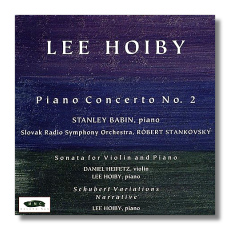
The Internet's Premier Classical Music Source
Related Links
- Latest Reviews
- More Reviews
-
By Composer
-
Collections
DVD & Blu-ray
Books
Concert Reviews
Articles/Interviews
Software
Audio
Search Amazon
Recommended Links
Site News
 CD Review
CD Review
Lee Hoiby

Orchestral Works
- Piano Concerto #2 1
- Schubert Variations 2
- Narrative 3
- Sonata for Violin & Piano 4
1 Stanley Babin, piano
2-4 Lee Hoiby, piano
4 Daniel Heifetz, violin
Slovak Radio Symphony Orchestra/Robert Stankovsky
MMC Recordings MMC2038 DDD 70:53
American composer Lee Hoiby was born in 1926, and this new CD is an excellent way to celebrate his seventieth birthday by getting to know him and his music. Many of his compositions are for voice, but his instrumental works also sing, as this collection shows.
Imagine if Rachmaninoff and Ravel jumped into Copland's clunky, old Ford convertible and took a cross-country tour of the United States – that's what Hoiby's second piano concerto (1979) sounds like. Fuddy-duddies will approve of its traditional construction (three movements in a fast-slow-fast pattern, recognizable themes that are developed in the classical manner, and so on), and young Turks will respond to its irrepressible high spirits, which range from urban metal to rural hay. Although they are not initially memorable, the concerto's themes and motifs begin to impress themselves upon the listener after a few listens. Like many things American, the music seldom goes where one expects it to go. Together, this unpredictability and the great technical demands made on the soloist (thickets of octaves, runs, and trills - particularly in the virtuosic Rondo finale) make Hoiby's concerto a plausible complement to a silent film by Harold Lloyd. Hardly profound or academic, this work nevertheless packs a lot of entertainment into its twenty-seven minutes. Much the same can be said of the Sonata for Violin and Piano, which recalls Prokofieff's neoclassical works. Its themes are angular and athletic, and its second movement (added in 1979 when the rest of this 1952 work was revised) is a scherzo whose motoric rhythms and insouciant contrasting sections sound like they could have come from one of the Russian master's lesser known ballets.
The ten Schubert Variations (1981) are based on a grave German Dance (#3; D. 366). Hoiby imaginatively deconstructs the dance's harmonic oddities, moving farther and farther from the original until regaining it in the final variation. Narrative (1983), a commission from the Artistic Ambassador Program of the United States Information Agency, was first performed in Cyprus. Harmonically, these two works for solo piano are more complicated than their discmates; they constitute a neo-impressionistic interlude to the two larger works.
The concerto receives an outstanding performance from Babin, and the orchestra sounds better and more thoroughly prepared than it has on other MMC recordings. Hoiby is an excellent pianist himself, and it's good to have him playing the other three works. Daniel Heifetz's theremin-like tone has more wire than allure. The sound is very good in the concerto, but a little murky in the other works, in spite of Marc Aubort's and Joanna Nickrenz's engineering for the latter.
Copyright © 1998, Raymond Tuttle












